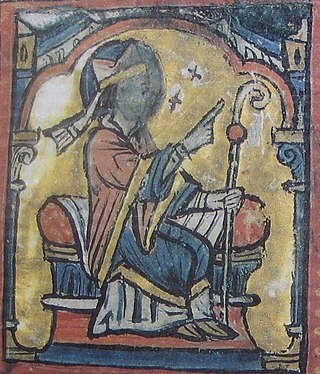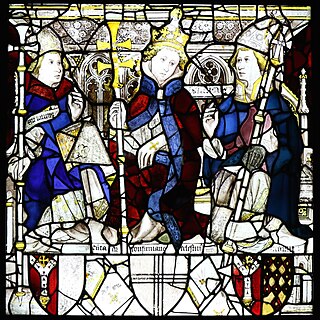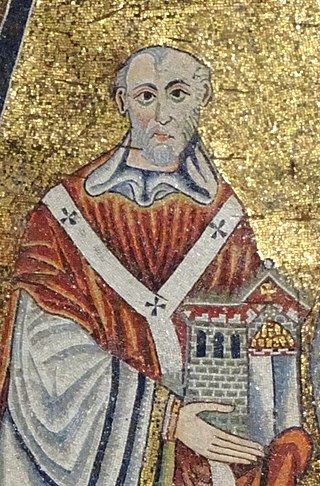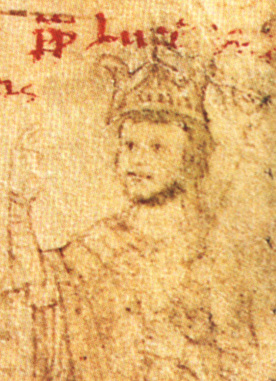History
The league was the work of Pope Celestine III and his two papal legates: Pandulf, cardinal priest of Santi Apostoli, and Bernard, cardinal priest of San Pietro in Vincoli. It was directed against the Holy Roman Emperor in alliance with the papacy. Its members swore not to make any alliances without papal approval, nor to make any peace or truce "with any emperor, king, prince, duke or margrave" without the approval of the rectors of the league. The original signatories were the communes of Lucca, Florence and Siena, the people living under the castles of Prato and San Miniato, and the bishopric of Volterra. The city of Arezzo joined on 2 December; Pisa refused and was placed under interdict by Celestine.
The real objective of the league was to secure for its members control of their respective regions. War was to be made on any city, town, count or bishop who refused to join the league when asked to do so, yet none were allowed to join without recognising their "legitimate" overlords, which in practice usually meant recognising one of the communes as lord. An exception was made for Poggibonsi, since there were many claims on it.
Shortly after the election of 1198, the new pope, Innocent III, condemned the Tuscan League as a dishonorable interference in the affairs of Tuscany, which he now claimed—on the basis of the Liber censuum (1192)—belonged entirely to the temporal jurisdiction of the Roman church. Celestine had not openly claimed authority in imperial or ducal Tuscany, but Innocent was prepared to extend papal claims to cover all of Tuscany. (The Tuscan duchy corresponded to old "Lombard" Tuscany, while papal Tuscany was "Roman", or suburbicarian, Tuscany—a distinction going back to the eighth century.) He thus revoked the interdict on Pisa and persuaded Viterbo and Perugia not to join. He sent Pandulf and Bernard back to try to negotiate the submission of the Tuscan cities and barons to him. Seven months of negotiations failed and Innocent was forced to accept the Tuscan League, even threatening Pisa with a renewed interdict.

Otto IV was the Holy Roman Emperor from 1209 until his death in 1218.

Pope Honorius II, born Lamberto Scannabecchi, was head of the Catholic Church and ruler of the Papal States from 21 December 1124 to his death in 1130.

Pope Honorius III, born Cencio Savelli, was head of the Catholic Church and ruler of the Papal States from 18 July 1216 to his death. A canon at the Basilica di Santa Maria Maggiore, he came to hold a number of important administrative positions, including that of Camerlengo. In 1197, he became tutor to the young Frederick II. As pope, he worked to promote the Fifth Crusade, which had been planned under his predecessor, Innocent III. Honorius repeatedly exhorted King Andrew II of Hungary and Emperor Frederick II to fulfill their vows to participate. He also gave approval to the recently formed Dominican and Franciscan religious orders.

Pope Clement III, was the head of the Catholic Church and ruler of the Papal States from 19 December 1187 to his death in 1191. He ended the conflict between the Papacy and the city of Rome, by allowing the election of magistrates, which reinstalled the Papacy back in the city after a six year exile. Clement, faced with a deplete college of cardinals, created thirty-one cardinals over three years, the most since Hadrian IV. He died 20 March 1191 and was quickly replaced by Celestine III.

Pope Celestine II, born Guido di Castello, was head of the Catholic Church and ruler of the Papal States from 26 September 1143 to his death in 1144.

Pope Celestine III, was the head of the Catholic Church and ruler of the Papal States from 30 March or 10 April 1191 to his death in 1198. He had a tense relationship with several monarchs, including Emperor Henry VI, King Tancred of Sicily, and King Alfonso IX of León.

Pope Celestine IV, born Goffredo da Castiglione, was head of the Catholic Church and ruler of the Papal States for only a few days from 25 October 1241 to his death on 10 November 1241.

Pope Innocent II, born Gregorio Papareschi, was head of the Catholic Church and ruler of the Papal States from 14 February 1130 to his death in 1143. His election as pope was controversial and the first eight years of his reign were marked by a struggle for recognition against the supporters of Anacletus II. He reached an understanding with King Lothair III of Germany who supported him against Anacletus and whom he crowned as Holy Roman emperor. Innocent went on to preside over the Second Lateran council.

Pope Innocent III, born Lotario dei Conti di Segni, was the head of the Catholic Church and ruler of the Papal States from 8 January 1198 until his death on 16 July 1216.

Pope Lucius III, born Ubaldo Allucingoli, reigned from 1 September 1181 to his death in 1185. Born of an aristocratic family of Lucca, prior to being elected pope, he had a long career as a papal diplomat. His papacy was marked by conflicts with Holy Roman Emperor Frederick I, his exile from Rome and the initial preparations for the Third Crusade.

The Duchy of Spoleto was a Lombard territory founded about 570 in central Italy by the Lombard dux Faroald. Its capital was the city of Spoleto.

The March of Tuscany was a march of the Kingdom of Italy and the Holy Roman Empire during the Middle Ages. Located in northwestern central Italy, it bordered the Papal States to the south, the Ligurian Sea to the west and Lombardy to the north. It comprised a collection of counties, largely in the valley of the River Arno, originally centered on Lucca.

Peter of Capua was an Italian scholastic theologian and prelate. He served as cardinal-deacon of Santa Maria in Via Lata from 1193 until 1201 and cardinal-priest of San Marcello al Corso from 1201 until his death. He often worked as a papal legate. He wrote several theological works and was a patron of his hometown of Amalfi.
Pandolfo da Lucca, erroneously Pandolfo Masca, was an Italian cardinal of the late 12th century. His name is sometimes given in the anglicised form Pandulf or Pandulph.

The 1198 papal election was convoked after the death of Pope Celestine III; it ended with the election of Cardinal Lotario dei Conti di Segni, who took the name Innocent III. In this election for the first time the new pope was elected per scrutinium.

The 1143 papal election followed the death of Pope Innocent II and resulted in the election of Pope Celestine II.
The 1144 papal election followed the death of Pope Celestine II and resulted in the election of Pope Lucius II.

Pietro Diani was an Italian cardinal. The name "Diana" is incorrect; he signs himself Petrus Dianus.
Melior, O.S.B. Vall. was a Benedictine monk, and a cardinal of the Roman Catholic Church. He was a native of Pisa. He served as papal legate in France for more than three years, trying to arrange a peace between Richard I and Philip II. He became a major negotiator, on the mandate of Pope Celestine III, in the divorce case between King Philip II of France and Queen Ingeborg of Denmark.
Enrico da Settala, sometimes anglicized Henry of Settala, was the archbishop of Milan from 1213 until his death.















